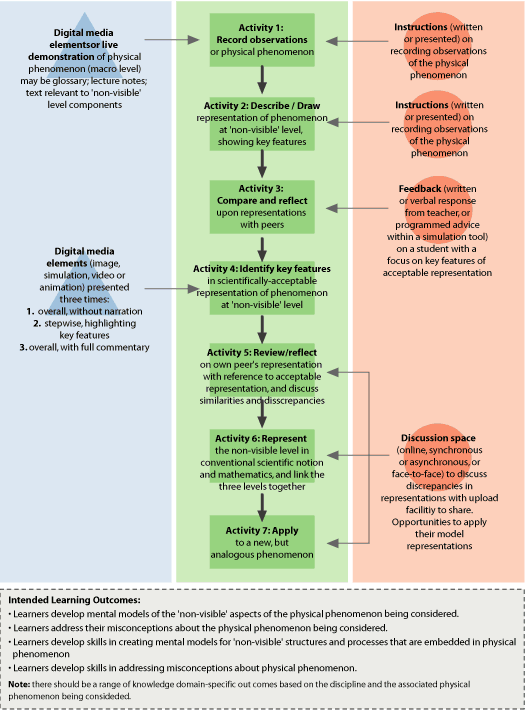|
WHAT KIND OF SUPPORT IS NEEDED?
The learner supports consist of:
- an introduction to the concept being investigated at the
observable level;
- a tool to facilitate the learner's representation of the
phenomenon as their mental model;
- feedback on the learner's representation; and
- a discussion space for a small group of learners to compare
and contrast their representations and that of the well-accepted
representation.
Support Element 1: Instructions on recording observations
and background content.
The sequence begins with background content and/or a demonstration
of a physical phenomenon, preferably in a live demonstration,
or if this is not appropriate, using digital or analogue video.
A simple example is the stretching of plastic Gladwrap®
to tearing point. The exercise is to list all the significant
observations, and this is not necessarily a trivial activity.
Support Element 2: Digital representation tool with
acceptable conventions for representing the non-visible level
in a drawing.
Instructions for students related to the drawing activity
and thus, using the digital representation tool should include
information about standard conventions of representation.
Students should be expected to use standard conventions (e.g.
molecular structure or vectors) in their describe/draw activity.
Where no standard exists the student should be expected to
develop their own convention and clearly indicate this through
a symbol key.
Support Element 3: Feedback on student representation
to enable focusing on key features.
Non-visible representations can be complicated so feedback
is needed to focus student attention on clearly communicating
the key features necessary to explain the observations of
the phenomenon. Feedback should be provided from both peers
and instructor.
Support Element 4: Focus on key features of acceptable
representation.
The acceptable representation should be shown three times:
- First, without commentary, with students encouraged to
look for the key features without assistance.
- Second, in segments, each with narration by the instructor
drawing attention to the important key features.
- Third, in its entirety, with full narration.
If students are focused on comparing features in their representation
with those in this representation, the impact is likely to
be greater. However, it is essential for all the key features
to be identified explicitly. Repeat viewing is advisable,
but this could be left to the other support resources (Resource
6) for another time.
Support Element 5: Discussion Space.
Students often do not realise they have misconceptions, or
have communicated misconceptions, in their drawings, unless
these are pointed out. Peer criticism is useful for this purpose.
Students need to be encouraged to relate the three thinking
levels in order to make sense of what they see in terms of
what is happening at the observable level, and interpret the
conventional scientific symbolism accordingly.
We have found that students need a physical 'memory' of the
learning experience in the form of some kind of handout.
Subsequent opportunities must be provided for students to
communicate their models of the non-visible world in lab reports
and tests. If students do not think they will be assessed
on these skills, they will not think they are worth the investment
of time and cognitive effort.
WHAT ARE THE CRITICAL FORMS OF SUPPORT
The supports are all essential.
WHAT IS THE SIGNIFICANCE OF THE SUPPORT STRATEGIES?
In our view, the sequence should take students carefully
through a mental journey requiring active thinking:
- from concrete to abstract levels (Support Elements 1 –
5);
- with focus on identifying key features of the non-visible
level (Support Elements 4);
- identifying misconceptions, if any (Support Element 5),
and application of visualisation skills to new chemical
systems (Support Element 7).
|
